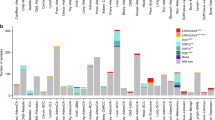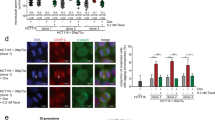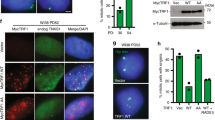Abstract
Aneuploidy is a fundamental principle of many cancer cells and is mostly related to defects in mitotic segregation of chromosomes. Many solid tumors as well as some preneoplastic lesions have been shown to contain polyploid chromosome numbers. The exact mechanisms behind whole-genome duplications are not known but have been linked to compromised mitotic checkpoint genes. We now report that the telomere checkpoint plays a key role for polyploidy in colon cancer cells. Telomerase suppression by a dominant-negative mutant of hTERT and consecutive telomere dysfunction in wild-type HCT116 colon cancer cells resulted in only minor stable chromosomal alterations. However, higher ploidy levels with up to 350 chromosomes were found when the cell-cycle checkpoint proteins p53 or p21 were absent. These findings indicate that telomere dysfunction in the absence of cell-cycle control may explain the high frequency of alterations in chromosome numbers found in many solid tumors.
This is a preview of subscription content, access via your institution
Access options
Subscribe to this journal
Receive 50 print issues and online access
$259.00 per year
only $5.18 per issue
Buy this article
- Purchase on Springer Link
- Instant access to full article PDF
Prices may be subject to local taxes which are calculated during checkout






Similar content being viewed by others
Abbreviations
- PD:
-
population doublings
- Q-FISH:
-
quantitative fluorescence in situ hybridization
- TRF:
-
telomere restriction fragment
- FACS:
-
fluorescence activated cell sorter
- GFP:
-
green fluorescent protein
- TFI:
-
fluorescence intensity of individual telomeres expressed in arbitrary units
- ΦNX:
-
phoenix ampho packaging cells
- SA:
-
senescence associated
- CIN:
-
chromosomal instability
References
Artandi SE, Chang S, Lee SL, Alson S, Gottlieb GJ, Chin L et al. (2000). Nature 406: 641–645.
Bharadwaj R, Yu H . (2004). Oncogene 23: 2016–2027.
Borel F, Lohez OD, Lacroix FB, Margolis RL . (2002). Proc Natl Acad Sci USA 99: 9819–9824.
Bunz F, Dutriaux A, Lengauer C, Waldman T, Zhou S, Brown JP et al. (1998). Science 282: 1497–1501.
Bunz F, Fauth C, Speicher MR, Dutriaux A, Sedivy JM, Kinzler KW et al. (2002). Cancer Res 62: 1129–1133.
Cahill DP, Lengauer C, Yu J, Riggins GJ, Willson JK, Markowitz SD et al. (1998). Nature 392: 300–303.
Chin L, Artandi SE, Shen Q, Tam A, Lee SL, Gottlieb GJ et al. (1999). Cell 97: 527–538.
Daniels MJ, Wang Y, Lee M, Venkitaraman AR . (2004). Science 306: 876–879.
de Lange T . (1995). In: Blackburn Ehg CW (ed). Telomeres. Cold Spring Harbor Laboratory Press: Cold Spring Harbor, NY, pp 265–293.
Edgar BA, Orr-Weaver TL . (2001). Cell 105: 297–306.
El-Daly H, Kull M, Zimmermann S, Pantic M, Waller CF, Martens UM . (2005). Blood 105: 1742–1749.
Feldser DM, Hackett JA, Greider CW . (2003). Nat Rev Cancer 3: 623–627.
Fernandez-Capetillo O, Nussenzweig A . (2004). Nat Genet 36: 672–674.
Filatov L, Golubovskaya V, Hurt JC, Byrd LL, Phillips JM, Kaufmann WK . (1998). Oncogene 16: 1825–1838.
Fukasawa K . (2002). Oncogene 21: 6140–6145.
Gisselsson D, Hoglund M . (2005). Semin Cancer Biol 15: 13–23.
Gisselsson D, Pettersson L, Hoglund M, Heidenblad M, Gorunova L, Wiegant J et al. (2000). Proc Natl Acad Sci USA 97: 5357–5362.
Gordon KE, Ireland H, Roberts M, Steeghs K, McCaul JA, MacDonald DG et al. (2003). Cancer Res 63: 458–467.
Hanks S, Coleman K, Reid S, Plaja A, Firth H, Fitzpatrick D et al. (2004). Nat Genet 36: 1159–1161.
Hansemann D . (1891). Arch Pathol Anat Phys Klin Med 119: 299–326.
Hede K . (2005). J Natl Cancer Inst 97: 87–89.
Herbig U, Jobling WA, Chen BP, Chen DJ, Sedivy JM . (2004). Mol Cell 14: 501–513.
Jallepalli PV, Lengauer C . (2001). Nat Rev Cancer 1: 109–117.
Maser RS, DePinho RA . (2002). Science 297: 565–569.
Murnane JP, Sabatier L . (2004). BioEssays 26: 1164–1174.
O'Sullivan JN, Bronner MP, Brentnall TA, Finley JC, Shen WT, Emerson S et al. (2002). Nat Genet 32: 280–284.
Pantic M, Zimmermann S, Waller CF, Martens UM . (2005). Int J Oncol 26: 1227–1232.
Popp S, Waltering S, Holtgreve-Grez H, Jauch A, Proby C, Leigh IM et al. (2000). J Invest Dermatol 115: 1095–1103.
Rajagopalan H, Jallepalli PV, Rago C, Velculescu VE, Kinzler KW, Vogelstein B et al. (2004). Nature 428: 77–81.
Rajagopalan H, Lengauer C . (2004). Nature 432: 338–341.
Rudolph KL, Millard M, Bosenberg MW, DePinho RA . (2001). Nat Genet 28: 155–159.
Saunders WS, Shuster M, Huang X, Gharaibeh B, Enyenihi AH, Petersen I et al. (2000). Proc Natl Acad Sci USA 97: 303–308.
Sen S . (2000). Curr Opin Oncol 12: 82–88.
Shichiri M, Yoshinaga K, Hisatomi H, Sugihara K, Hirata Y . (2002). Cancer Res 62: 13–17.
Smogorzewska A, de Lange T . (2002). EMBO J 21: 4338–4348.
Stewenius Y, Gorunova L, Jonson T, Larsson N, Hoglund M, Mandahl N et al. (2005). Proc Natl Acad Sci USA 102: 5541–5546.
Vogelstein B, Lane D, Levine AJ . (2000). Nature 408: 307–310.
Wang RH, Yu H, Deng CX . (2004). Proc Natl Acad Sci USA 101: 17108–17113.
Wright WE, Shay JW . (2000). Nat Med 6: 849–851.
Zimmermann S, Glaser S, Ketteler R, Waller CF, Klingmüller U, Martens UM . (2004). Stem Cells 22: 741–749.
Acknowledgements
We gratefully acknowledge the excellent technical assistance from I Skatulla. We also thank B Vogelstein for providing the HCT116 cells. In addition, we are indebted to R Weinberg and H Vaziri for providing the retroviral hTERT construct. This work was supported by grants from the Deutsche Forschungsgemeinschaft (SFB 364) (to UM), Deutsche Krebshilfe eV (to PB) and from the European Union (QLG1-CT-1999-01341 and MOL CANCER MED) (to UM and PB).
Author information
Authors and Affiliations
Corresponding author
Rights and permissions
About this article
Cite this article
Pantic, M., Zimmermann, S., El Daly, H. et al. Telomere dysfunction and loss of p53 cooperate in defective mitotic segregation of chromosomes in cancer cells. Oncogene 25, 4413–4420 (2006). https://doi.org/10.1038/sj.onc.1209486
Received:
Revised:
Accepted:
Published:
Issue Date:
DOI: https://doi.org/10.1038/sj.onc.1209486
Keywords
This article is cited by
-
Glucose restriction decreases telomerase activity and enhances its inhibitor response on breast cancer cells: possible extra-telomerase role of BIBR 1532
Cancer Cell International (2014)
-
Telomeric and extra-telomeric roles for telomerase and the telomere-binding proteins
Nature Reviews Cancer (2011)
-
p53 suppresses structural chromosome instability after mitotic arrest in human cells
Oncogene (2010)
-
Aurora A is differentially expressed and regulated in chromosomal and microsatellite instable sporadic colorectal cancers
Modern Pathology (2009)



